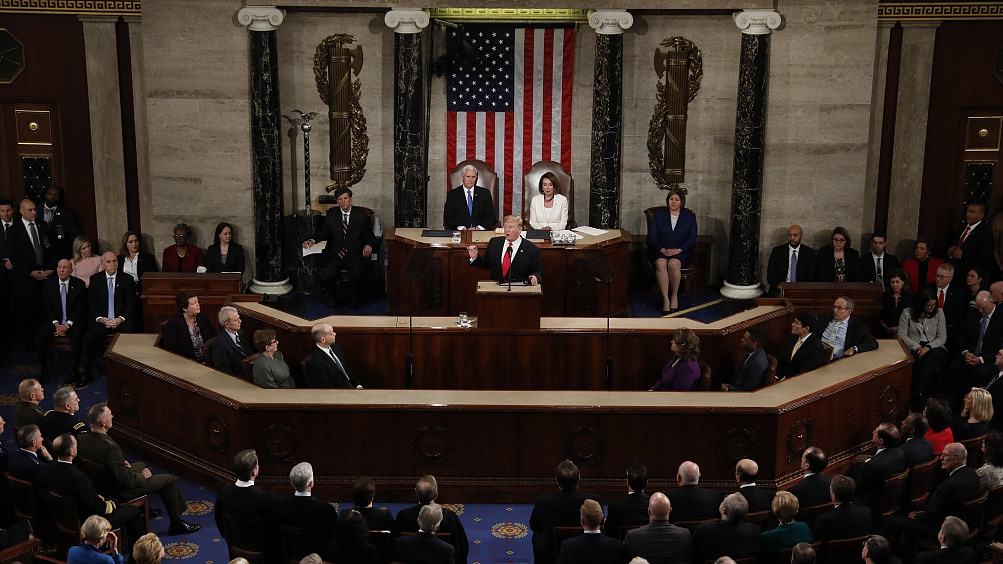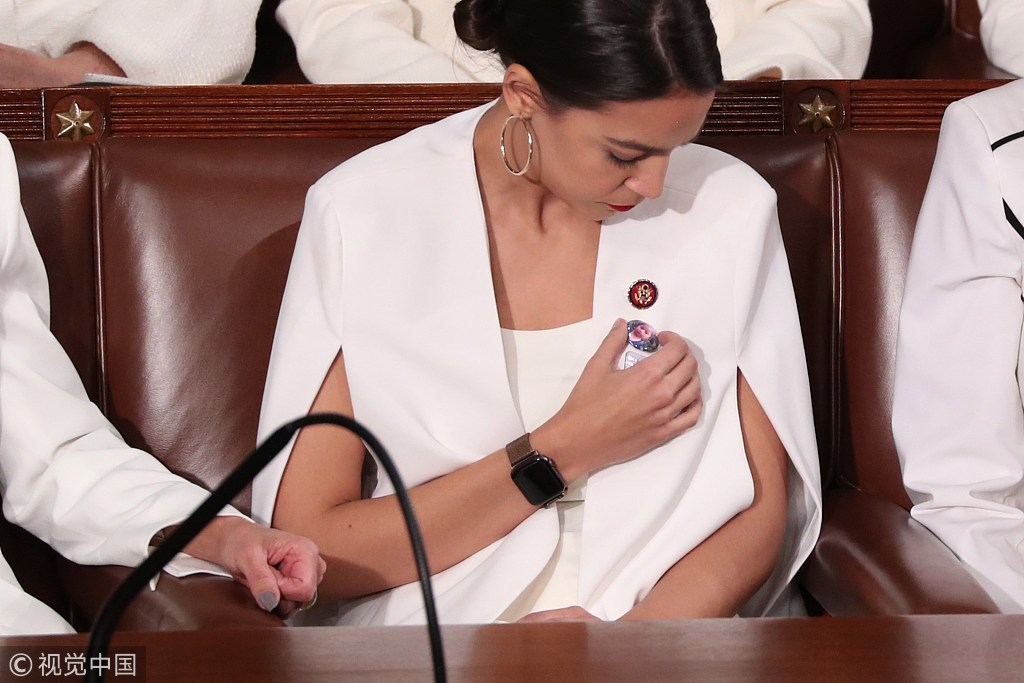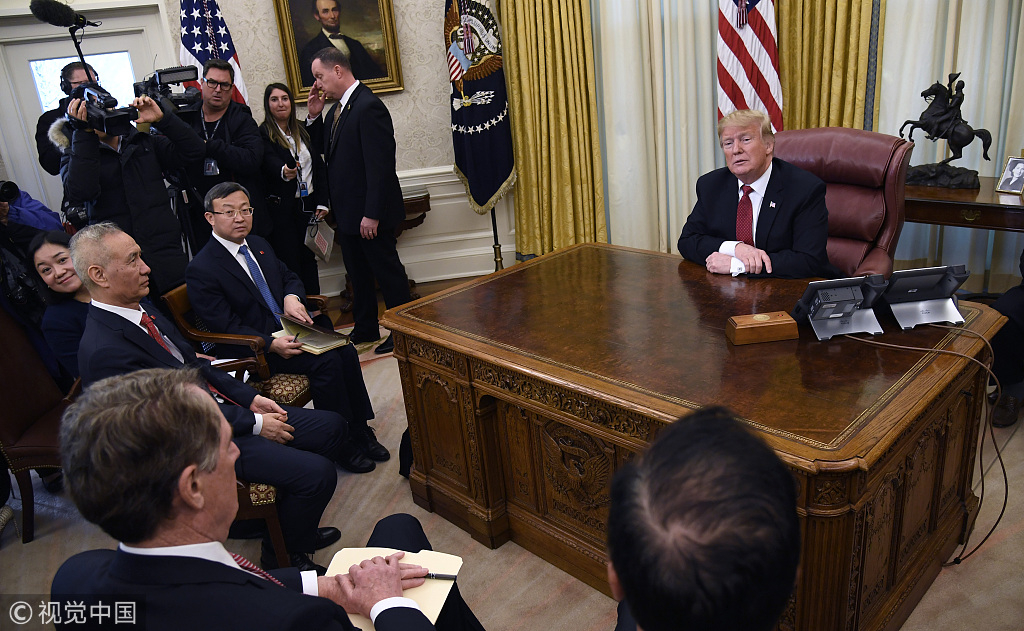
Opinion
16:31, 06-Feb-2019
Opinion: Unity and division-an interesting juxtaposition in Trump's speech
Updated
17:03, 06-Feb-2019
Yuan Sha

Editor's note: Dr. Yuan Sha is an assistant research fellow at the Department for American Studies, China Institute of International Studies. The article reflects the author's opinion, and not necessarily the views of CGTN.
After the drama of dis-invitations and re-invitations, U.S. President Donald Trump finally delivered his much-anticipated State of the Union address to a joint session of Congress on the night of February 5. What is interesting in this address is a rare juxtaposition of unity and division. Despite his wish to strike a bipartisan note, Trump was reluctant to squander the opportunity to advance his polarizing agenda on the “bully pulpit.”
'Choosing greatness'
President Trump made calling for unity a core theme of his second State of the Union address, and he tried hard to reach across the aisle.
As was usual, he touted his success in delivering the “hottest economy” in the world, with unprecedented growth in jobs and wages. He proclaimed that “the state of our union is strong” and called for the Americans to “choose greatness.”
He deliberately talked about issues with broad bipartisan consensus, from social policies such as building the dilapidated infrastructure, fighting HIV aids, and cutting prices for prescription drugs, to foreign policies such as continuing trade negotiations with China, denouncing Venezuela's Nicolas Maduro government and supporting Israel.
He also flared up American patriotism, from celebrating the anniversaries of the D-Day and first Moon-landing, to declaring the U.S. as the net exporter of energy, to citing moving stories of individual Americans.
He even catered to female representatives who wore white clothes today to celebrate American women's achievements in the economy, society, and politics.

Representative Alexandria Ocasio-Cortez looks down at a button with a picture of a child as U.S. President Donald Trump talks about immigration during his second State of the Union address to a joint session of Congress at the U.S. Capitol in Washington, U.S., February 5, 2019. /VCG Photo
Representative Alexandria Ocasio-Cortez looks down at a button with a picture of a child as U.S. President Donald Trump talks about immigration during his second State of the Union address to a joint session of Congress at the U.S. Capitol in Washington, U.S., February 5, 2019. /VCG Photo
His call for unity reached a climax when he declared “we govern not as two parties, but as one nation”, cautioned “we must reject the politics of revenge, resistance and retribution”, and promised “we can bridge old divisions, heal old wounds, build new coalitions, forge new solutions, and unlock the extraordinary promise of America's future. The decision is ours to make.”
'Walls work and walls save lives'
After calling for bipartisanship, he returned to the old practice of partisan politics. With the deadline of government shutdown negotiation approaching, he devoted a significant amount of time to sell his signature border wall.
First of all, he sounded the alarm over the “urgent national crisis” at U.S. southern border. He warned of the “caravan” migrants posing a rising menace to the American national security, talking about coyotes, drug cartels, human trafficking, and criminal illegal aliens. He even claimed “countless Americans” were murdered by undocumented immigrants.
Then, he insisted on a harsh policy on illegal immigration. To everyone's surprise, he announced to order another 3,750 troops to the Southern border. He also promised to never abolish Immigration and Customs Enforcement (ICE) and reiterated his unwavering support to build the wall. Despite shifting from a concrete wall to a “smart, strategic, see-through steel barrier”, he argued that “walls work and walls save lives”, and firmly stated “I will get it built”.
The funny scene is that half of the audience stood up, applauding for this resounding determination, and the other half sat still, rigid and calm. Although he just reiterated the importance of cooperation of both parties minutes ago, the dividing scene is an obvious proof that it is not an easy task.

President Donald Trump (R) makes remarks during a meeting with the Chinese trade delegation headed by Vice Premier Liu He (L) as U.S. Trade Representative Robert Lighthizer (L, foreground) attends, at the White House, Washington, DC, January 31, 2019. /VCG Photo
President Donald Trump (R) makes remarks during a meeting with the Chinese trade delegation headed by Vice Premier Liu He (L) as U.S. Trade Representative Robert Lighthizer (L, foreground) attends, at the White House, Washington, DC, January 31, 2019. /VCG Photo
Lastly, he tried to denigrate his opponents. With his archrival House Speaker Nancy Pelosi staring him from behind, he proclaimed, “tolerance for illegal immigration is not compassionate, it is cruel”, and “no issue better illustrates the divide between America's working class and America's political class than illegal immigration. Wealthy politicians and donors push for open borders while living their lives behind walls and gates and guards.” He then urged Congress to “fund our government, protect our homeland and secure our southern border”. In casting immigration as a moral issue, he tried to refashion the whole debate to his favor.
Unity vs. division
Such a juxtaposition of unity and division might get one perplexed over the real message that President Trump is trying to convey. In fact, he is trying to act Presidential and as himself at the same time, and it just reveals a dilemma facing the Trump Presidency.
On the one hand, two years after assuming office, President Trump might finally come to realize that he needs a broader audience, more balanced rhetoric, and bipartisan support. In this respect, his new approach worked. His bipartisan rhetoric helped him win genuine applause from Republicans and Democrats alike.
On the other hand, he cannot help but retire to his old Self in an effort to retain his base. His adamant stance on such controversial issues as immigration and abortion just reflects how deep the fissures in American society are.
With these contradictions, this address is unlikely to fulfill its claimed task of breaking the current political stalemate. Congressional Democrats, coming out of the government shutdown crisis hardened and vindicated, are unlikely to give in easily. In fact, Democrats are staging a quiet protest with some refusing to attend and activists on immigration, climate change, women's right, and some furloughed government employees invited in the audience.
More importantly, behind the applauding and smiling façade lies deep fissions, rising polarization and lack of trust. It might be ok for him to use divisive rhetoric to rally support on the campaign trail, but running a government is a whole other thing.
His divisive rhetoric would further worsen the polarization across the political fault-line. And it seems naïve for Trump to really believe that his de-constructive approach would really help him reconstruct a world of his own liking.
(Cover photo: U.S. President Donald Trump delivers a State of the Union address to a joint session of Congress at the U.S. Capitol in Washington, DC, U.S., February 5, 2019. /VCG Photo)
(If you want to contribute and have specific expertise, please contact us at opinions@cgtn.com.)

SITEMAP
Copyright © 2018 CGTN. Beijing ICP prepared NO.16065310-3
Copyright © 2018 CGTN. Beijing ICP prepared NO.16065310-3